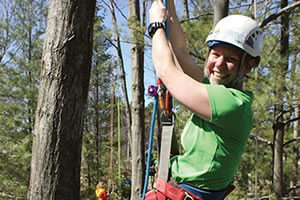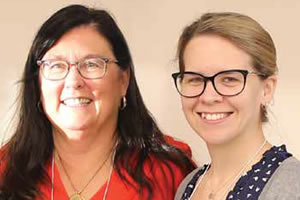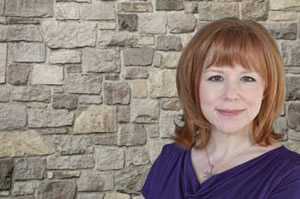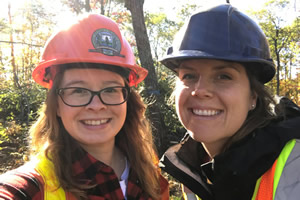Women championing women in forestry
We have archived this page and will not be updating it.
You can use it for research or reference.
Source: The State of Canada’s Forests Annual Report 2019. Download the PDF version from our publications database.
Women are still under-represented in forestry – but here are six women working to change that.

Katrina Van Osch-Saxon:
Increasing enrollment in forestry programs
Professor Katrina Van Osch-Saxon started teaching at Fleming College’s School of Environmental and Natural Resource Sciences (located on Frost Campus in Kawartha Lakes, Ontario) in 2012 – and immediately noticed that women were greatly under-represented in the programs. Van Osch-Saxon thought that a root cause may be a lack of awareness about the diversity and breadth of opportunities in forestry-related industries. Even growing up working in arboriculture with her father, Van Osch-Saxon didn’t really realize the potential career opportunities for herself. So, in 2016 she spearheaded the “Women In Trees” event at Fleming College’s Frost Campus. There representatives from urban forestry, forestry, and arboriculture industries spoke to female students – as well as the general public – about opportunities available to them in tree-related careers.
Van Osch-Saxon started Women In Trees as a one-time initiative, but the event was so successful and received so enthusiastically that she hosted it again in 2017 and 2019. Van Osch-Saxon has had students tell her that it was the Women In Trees event that led them to enroll in one of the forestry programs at Fleming. In fact, her colleague Joanna Hodge, a professor in the School of Environmental and Natural Resource Sciences at Fleming College, was also inspired by Van Osch-Saxon’s success. Hodge organized her own inaugural “Women In Rocks” event, designed to highlight the opportunities for women in earth sciences. Keeping in the spirit of “women helping women,” Van Osch-Saxon and Hodge plan to continue to build on their respective successes by amalgamating their areas of passion under the umbrella “Women in Natural Resources” (WINRS). WINRS will take place in the spring of 2020 at Frost Campus, where several programs have planned activities to showcase potential career opportunities for women in natural resources.

Cindy Shaw and Dr. Nicole Heshka:
Mentoring the next generation of role models through truth and reconciliation
The SINEWS bursary program got its name from its mandate: Sistering Indigenous and Western Science. Inspired by women mentors throughout their own careers, Natural Resources Canada researchers Cindy Shaw and Dr. Nicole Heshka created the one-year pilot bursary program by combining two of their passions: increasing opportunities for women and improving Indigenous relations.
Applicant teams consist of two women – one Indigenous and one non- Indigenous – competing for a $12,000 bursary. Applicants must demonstrate that their scientific project is consistent with public Indigenous interests and is in an area relevant to forestry and other areas of Natural Resources Canada’s research mandate. Shaw and Heshka believe that by integrating different experiences and perspectives “women can play a significant role in truth and reconciliation between Canada’s Indigenous and non-Indigenous communities.” They also believe the integration can create more opportunities and support for women in science. The researchers were shocked at the large response: 74 applications for the bursary from across Canada. The SINEWS team ultimately awarded the bursary to 16 students (i.e. 8 pairs).
The concept of increasing mentorship opportunities for women in natural resources is close to both Shaw’s and Heshka’s hearts. “Ultimately, we want these students to go back to their communities and be role models, mentors, and/or inspirations to other women in the community,” says Shaw. Adds Heshka, “I was lucky to have incredible mentors and role models throughout my studies and professional career, which gave me the strength to stand up for myself and succeed. We want to continue building that mentorship capacity in the younger generation of women.”

Tanya Wick:
Re-imagining the forest industry
Tanya Wick is Tolko Industries Ltd.’s first female vice-president, and she says she did it by being unabashedly confident. For Wick, career success is “not about using your masculine traits to become ‘one of the guys’; it’s about incorporating women’s ideas and ways of thinking into the business. I encourage women not to be afraid of doing things your own way – believe in yourself and get your ideas out there.”
Wick has become an outspoken champion for diversity and inclusion in the forest industry. She has focused on changing the mindset that it is not a place for women while also advocating for greater career development opportunities for women. Wick believes that women shouldn’t be promoted simply because they are women, but because the industry wants to attract and retain the best and brightest. To do that, Wick believes, the industry should strive to ensure that women who have great skills and ability are promoted and seen as role models for the industry. Wick puts her money where her mouth is. To date, she has helped launch Tolko’s Women in the Workforce Strategy, joined the National Steering Committee for Gender Equity in Canada's Forest Sector, and was awarded the Forest Products Association of Canada (FPAC) Women in Forestry Award of Excellence in 2018.

Lacey Rose and Jess Kaknevicius:
Forging connections and enhancing support
After repeatedly finding themselves in the minority at forestry events, Lacey Rose and Jess Kaknevicius joked about starting an official “club” for women in forestry. A few years later, Rose and Kaknevicius launched Women In Wood (WIW). WIW was started in 2015 as a networking group for women “who work in, with and for the woods.” Since then, the Facebook group has grown to almost 1,000 women across Canada, the United States and beyond, and WIW has organized and attended numerous forestry networking events.
Rose and Kaknevicius say that the phenomenal success of this group is due to the passion and rapport within the community of women who have come together to offer support, share stories, mentor each other, and ask questions. Both staunch advocates of increasing the number of women in forestry, Rose and Kaknevicius say that they are personally uplifted by the connections. Rose recalls one memorable discussion about working alone in bear country, when an outpouring of advice and support from other women in WIW alleviated a new forester’s anxiety. “How many women before her have called it quits because they did not have anyone to discuss with?” wonders Rose.

Sources
- Forest Products Association of Canada. The Importance of Women In Our Workforce – Message from Tanya Wick, Tolko, VP People and Services. (September 26, 2018).
- Sistering Indigenous and Western Science.
- Tolko. Tanya Wick: Blazing trails for women in forestry.
- Women In Wood.
Photo credits
- Photo of Katrina Van Osch-Saxon courtesy of Fleming College.
- Photo of Cindy Shaw and Nicole Heshka courtesy of Cindy Shaw and Nicole Heshka.
- Photo of Tanya Wick courtesy of Tolko Industries Ltd.
- Photo of Lacey Rose and Jess Kaknevicius courtesy of Lacey Rose.
Page details
- Date modified: